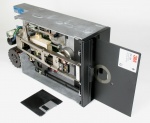Security and Storage Mediums
From Computing and Software Wiki
(→Compact Discs) |
|||
| Line 7: | Line 7: | ||
* Relatively Cheap and Efficient | * Relatively Cheap and Efficient | ||
| - | == Floppy Disks == | + | == Example Storage Devices == |
| + | === Floppy Disks === | ||
[[Image:Floppy_Disk_Drive_8_inch.jpg|thumb|150px|right| | [[Image:Floppy_Disk_Drive_8_inch.jpg|thumb|150px|right| | ||
'''Size Comparison between 3.5" Floppy (Left) and 8" Floppy (Right)''']] | '''Size Comparison between 3.5" Floppy (Left) and 8" Floppy (Right)''']] | ||
The introduction of Floppy Disks was one of the first widely accepted form of use of an external device to act as a storage medium. Althought "Floppy" Disks are fairly rigid in composure, the name actually comes from the very first released disk, 8-inch - IBM 23FD[[http://en.wikipedia.org/wiki/Floppy_disk#Origins.2C_the_8-inch_disk]], in 1971. This disk had a capacity of approximately 79.7 KB, and was, as the name implies, soft and floppy in nature. | The introduction of Floppy Disks was one of the first widely accepted form of use of an external device to act as a storage medium. Althought "Floppy" Disks are fairly rigid in composure, the name actually comes from the very first released disk, 8-inch - IBM 23FD[[http://en.wikipedia.org/wiki/Floppy_disk#Origins.2C_the_8-inch_disk]], in 1971. This disk had a capacity of approximately 79.7 KB, and was, as the name implies, soft and floppy in nature. | ||
| - | == Compact Discs == | + | === Compact Discs === |
With the introduction of Compact Discs (more commonly known as CDs) the first real, mainstream alternative to Floppy disks made its appearance. The very first Compact Disc that was created for commercial use was produced at a Philips factory in Langenhagen, Germany on August 17, 1982. [[http://en.wikipedia.org/wiki/Compact_discs#History]] | With the introduction of Compact Discs (more commonly known as CDs) the first real, mainstream alternative to Floppy disks made its appearance. The very first Compact Disc that was created for commercial use was produced at a Philips factory in Langenhagen, Germany on August 17, 1982. [[http://en.wikipedia.org/wiki/Compact_discs#History]] | ||
Allowed for a fairly secure storage of data by making it read only. | Allowed for a fairly secure storage of data by making it read only. | ||
| Line 20: | Line 21: | ||
* Illegal Sub-Channels (Left over data filled) | * Illegal Sub-Channels (Left over data filled) | ||
| - | == Digital Video Discs == | + | === Digital Video Discs === |
| - | == USB Keys == | + | === USB Keys === |
== Security Measures == | == Security Measures == | ||
Revision as of 23:21, 1 December 2007
Storage mediums today, whether they be in the form of CDs, DVDs, USB Keys, or another form, are one of the primary methods of transferring information on a small scale. Since the introduction of floppy disks in 1971, storage mediums have been accepted by society as an integral part of the technological age and in turn, advances are made frequently in order to furthur fulfill the end-users needs.
Contents |
Benefits of Storage Devices
- Data Protection
- Ease of Use
- Easy to Transport Information
- Relatively Cheap and Efficient
Example Storage Devices
Floppy Disks
The introduction of Floppy Disks was one of the first widely accepted form of use of an external device to act as a storage medium. Althought "Floppy" Disks are fairly rigid in composure, the name actually comes from the very first released disk, 8-inch - IBM 23FD[[1]], in 1971. This disk had a capacity of approximately 79.7 KB, and was, as the name implies, soft and floppy in nature.
Compact Discs
With the introduction of Compact Discs (more commonly known as CDs) the first real, mainstream alternative to Floppy disks made its appearance. The very first Compact Disc that was created for commercial use was produced at a Philips factory in Langenhagen, Germany on August 17, 1982. [[2]] Allowed for a fairly secure storage of data by making it read only. Lead to the introduction of many different types of copy protection techniques:
- Dummy Files (Illegal file headers)
- Illegal Sectors (Error Detection Code, using checksums)
- Illegal Sub-Channels (Left over data filled)
Digital Video Discs
USB Keys
Security Measures
References
Security Risks Associated With Portable Storage Devices
Demand for Personal Storage Devices to Grow
See Also
External Links
CD-Lock
CD and DVD Copy Protection
Floppy Disks
SecuROM
SafeDisc
--Cavaliaj 17:20, 1 December 2007 (EST)

